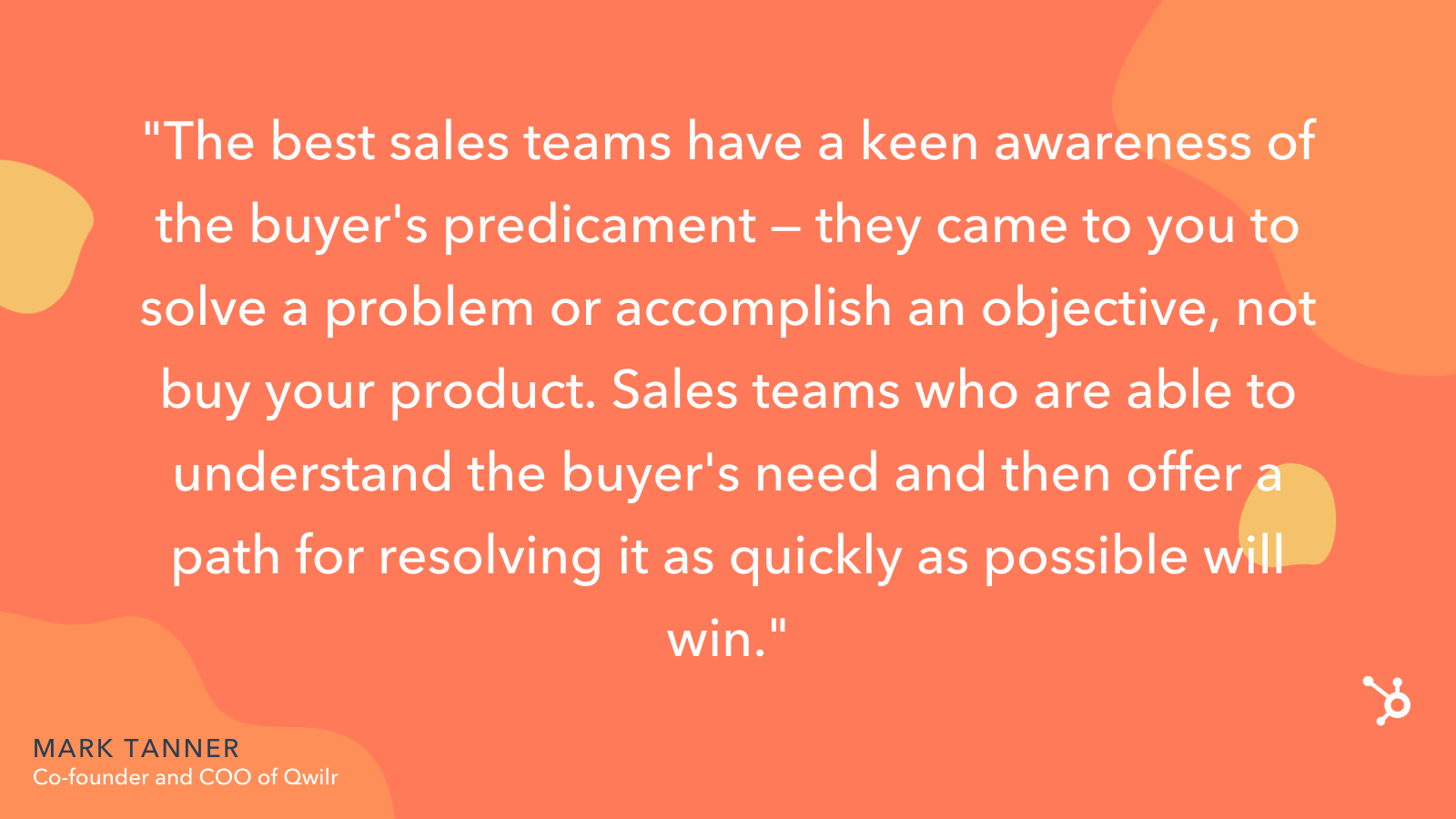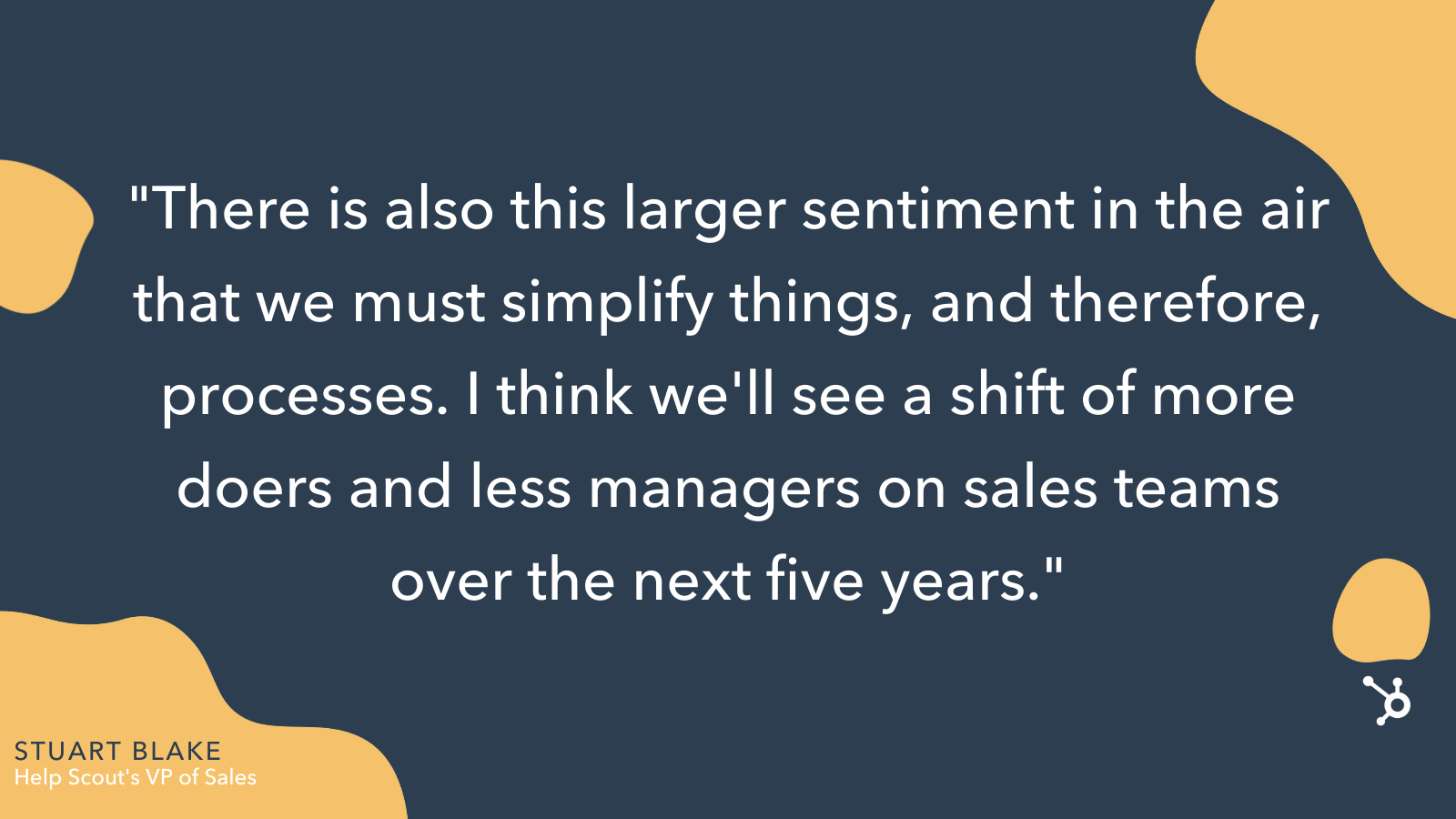Drone deliveries. Space tourism. Virtual reality birthday parties.
When thinking about the future, it’s relatively easy (and fun) to picture what the world might look like in 10, 20, or even 50 years.
But what about the future of sales?
In this case, I’m not talking about the trends we’ll see in 2022 (although those are important). I’m talking long-term.
Over the next five or ten years, how will we begin to see sales evolve? Will sales floors look different? What types of emerging technologies will become commonplace? How might the job of a sales leader change?
Here, we spoke with four sales leaders to get their insights into the future of sales. Let’s dive in.
The Future of Sales
1. Trust will remain critical for winning deals.
David Bell, Executive General Manager of Partner Sales at global small business platform Xero, says an enduring sales trend — and something he believes won’t change — is the need for a depth of trust established through relationships.
“With the advent of AI-driven CRM systems, and the explosion of channels, the ability to create and sustain trust could easily be lost,” He told me.
Bell says, “Those businesses that can retain the ‘human touch’, creating that all important emotional connection across all channels, whether digital or physical conversations, will likely outperform those that don’t.”
Bell adds, “Those sales teams that harness the power of data to add more value to relationships through data-driven marketing will also benefit.”
2. Sales reps will focus more on the buyer’s experience to shorten sales cycles.
According to the 2021 Buyer Experience Study, 80% of SaaS buyers report the buying process is too cumbersome — too many steps, too complicated, and too much paperwork, to name a few of the frustrations.
Mark Tanner, Co-founder and COO of Qwilr, believes that in the future, sales reps will need to exercise empathy towards the buyer’s journey and do what they can to alleviate those challenges.
He says, “The best sales teams have a keen awareness of the buyer’s predicament — they came to you to solve a problem or accomplish an objective, not buy your product. Sales teams who are able to understand the buyer’s need and then offer a path for resolving it as quickly as possible will win.”

Tanner adds, “All buyers share the same time constraints and pressures — researching and buying a solution is only part of their job. A salesperson can really streamline the buying process by making it more convenient for the buyer and reducing purchasing friction,” said Tanner.
Simply put, the future of sales looks easier for the buyer than it is right now.
Focusing on your buyer’s needs isn’t just good for the buyer. It’s also good for your bottom-line. As Tanner puts it, “When you focus on the needs of your buyer, you not only improve the buyer’s experience, but you also accelerate closing the deal. In fact, I’ve seen teams shorten their sales cycle by as much as 65%.”
To reduce friction, consider areas of your current sales process that aren’t the easiest for your buyer. One area Tanner suggests re-evaluating is the pricing discussion. He told me configurable pricing and e-signatures embedded into sales proposals are effective solutions for reducing time spent negotiating.
3. The hierarchical nature of sales will flatten.
Help Scout’s VP of Sales, Stuart Blake, believes over the next five years, we’ll see a flattening of the hierarchical nature of sales organizations.
He says, “This has been happening for the last five to 10 years, but I hypothesize that it will accelerate over the next five. The main reasons why I foresee this is because more people are working from home — leading to more focus on the output of work, the leveraging of technology to get that output, and cleaner communication.”
Blake adds, “There is also this larger sentiment in the air that we must simplify things, and therefore, processes. This move might end up being short-lived, but I think we’ll see a shift of more doers and less managers on sales teams over the next five years.”
Take this time to re-consider your existing strategy. You might determine there are more effective ways to organize your sales organization structure — enabling new opportunities for your sales rep as the industry evolves.

4. Meaningful interactions and relationship-building will be vital for long-term success.
“The long-term trend is going to be about meaningful interaction, communication, relationship building, and problem-solving,” Judson Griffin, Intercom’s Senior Director of NORPAC Sales, told me.
Consumers expect more from the buyer’s experience than they did a few years ago. Social media, blogs, and other content marketing channels have made it easy for buyers to educate themselves, so sales reps will need to evolve into more of a consultant role to continue succeeding.
Griffin adds, “Organizations that are creating the culture and investing in technology that allows their teams to collaborate, problem solve, and focus on selling to the right customer goals will win.”
5. Each part of the sales process will become more specialized.
Matt Sunshine, Managing Partner for The Center for Sales Strategy and LeadG2, believes the future of sales includes more specialization for each stage of the sales process.
As he puts it, “The process will be broken up into a few parts — depending on what you’re selling — with one person focusing on each part. Lead generators and marketers will produce leads, project managers will do research and pre-sale activities, account executives will conduct discovery work, presentation, and deal closures, and account managers will implement what’s been sold — all while providing customer service.”
To prepare, consider how you might train reps or teams within your sales organization for specific skills related to your buyer’s journey. For instance, you might prepare one sales rep for prospecting, another for outreach and discovery, and another for negotiations and closing.
This will look different for each organization depending on your sales strategy and buyer’s journey, but it will ultimately help you more efficiently train each rep to reach their highest potential in one category related to the larger sales process.
How Sales Jobs Could Change in the Next Decade
As some of these trends are shifting, here’s how we think sales jobs could change.
1. Larger companies will have defined roles, and smaller organizations will look for adaptable people to perform multiple functions.
As effective selling begins earlier in the sales process and the relationship continues after the sales, adaptability will be increasingly important in the sales role. Smaller companies will rely on multi-talented people for account management and customer success, so the lines may become blurred. Larger organizations, however, may break this up into multiple roles but still value cross-functional talent.
2. Robust sales tools will be considered coworkers.
With reliance on AI and cross-functional teams increasing, so too does the need for elegant sales software solutions that enable reps to make data-driven decisions and/or improve productivity. The more sales tools that are needed (or the more elegant the solution), the more the company will invest in them, money-wise and time-wise. These solutions will be integrated into every facet of the sales process and beyond.
3. Tech-savviness will be part of the job description.
Reliance on email and tech is already making tech skills more important in the world of sales. Familiarity with the most popular CRMs, comfortability with email communication and automation, and the ability to navigate the internet and social platforms are examples of skills that are necessary now more than ever. As technology advances, so too will the tech requirements for sales hires.
As Zenaida Lorenzo, Lead Sales Trainer at Unstopped Sales & Pareto Law, told me, “Email has had a big influence on selling. Although its been around for 20+ years, more and more sales communications happen over email. Salespeople must be able to express themselves well through writing, which can be challenging.”
4. Entry-level sales roles will require more experience or focus on soft skills.
As some of the more manual and less strategic tasks of sales (such as prospecting and following up) can be automated out effectively, entry-level sales roles that spent a lot of time performing these tasks will need to evolve. It’s possible that the “entry-level” gets bumped up to require more experience. Alternatively, organizations may evaluate reps based on softer skills, such as writing, to get more out of new hires.
5. More organizations will say goodbye to having the whole team under the same roof.
With SAAS and other solutions emerging, more companies are targeting national or even international pools of customers. This combined with the need for more experienced sales reps, the need for more diverse teams, and inside sales trends, there will be a continuing shift toward remote work. Changing attitudes toward telecommuting and technology making it even easier to connect with team members will result in more integrated but geographically distant sales departments. And talent will be more accessible.
6. Sales people with large existing networks will be highly sought after.
With marketing doing a lot of legwork to fill pipelines, additional prospecting being automated more and more, and a rise in self-serve purchasing, the value that sales professionals add will be in their ability to forge strong relationships and build trust. That puts candidates with existing networks at an advantage with proof of their adeptness at making connections.
Whatever the future of sales is, it’s never been a more exciting time for the profession. By having the experts look at where sales has been and where it’s likely going, it’s clear to see the future leaves plenty of room for innovation, education, and kick-ass salespeople.
Editor’s note: This post was originally published in May 2018 and has been updated for comprehensiveness.

![]()


